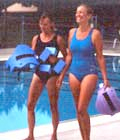Water Running Handbook – Part 2
Before you Start…
Safety:
Before embarking on any exercise program, you should be examined by a physician, particularly if you have any known heart or blood pressure problems, any metabolic disorders, or have been previously inactive. The instructions and advice presented here are not intended as a substitute for medical counseling. Not all exercises are suitable for all people. Start at an easy or beginning level and then work up to more advanced levels as you gain conditioning and experience. Never run or exercise in the water alone.
Equipment:
Wear an AquaJogger® flotation belt. It is nearly impossible to maintain the correct movement patterns without one. If you are working out in a confined area, you may want to use a tether such as the AquaHitch. Other options that will add more intensity and variety to your workouts include AquaRunners® for your feet, hand-held DeltaBells®, and/or WebPro Gloves® for increased upper body resistance.

Pool depth:
The depth of water you need for deep water running is determined by your height. The water level should be at least up to your chin so that your feet are off the bottom of the pool once you put on your buoyancy device. This usually requires a pool depth that is at minimum about 6″ less than your height.
Flotation and buoyancy:
It is important that you have sufficient flotation support for the body so that you can comfortably keep your head above water without compromising your running form. Your body’s natural flotation level will determine the amount of additional buoyancy you need.

A good test to determine the additional flotation required is to get in the water without a buoyancy device and tread water. If you can stay up easily when treading without a buoyancy device, the AquaJogger® Classic will work for you.
Fat floats while muscle and bone tend to sink. A dense muscle mass or bone structure and a low fat ratio make flotation difficult. If you find you have difficulty treading water, the AquaJogger® Pro, with 30% more flotation than the Classic, is a better choice. If you are a sinker and have great difficulty staying afloat, you need the AquaJogger® Pro Plus with 50% more flotation than the Classic.
The AquaJogger® Pro and Pro+ are recommended for most athletes and those who have high buoyancy needs because of physical limitations or fear of water. Additional buoyancy is also added by using AquaRunners® or adding a VersaFloats® (foam pads that can be inserted in front or in the back of an AquaJogger to provide additional flotation). DeltaBells® also provide extra buoyancy as well as resistance for upper body moves.
Water temperature:
Most athletes train in water that ranges from 82-86 degrees Fahrenheit. Water temperature should not exceed 90 degrees Fahrenheit for a training session. If the water becomes colder than 80 degrees Fahrenheit, you may become uncomfortable due to problems maintaining body temperature and performance.
